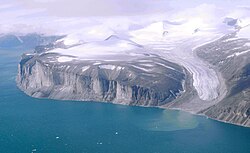Helluland
[citation needed] The name Helluland was given by Leif Erikson during his voyage to Vinland according to the Greenland Saga and means "Land of Flat Rocks/Stones" in Old Norse.
"[3]In the Saga of Halfdan Eysteinsson (Hálfdanar saga Eysteinssonar), written no earlier than the mid-14th century a fragment says:[5] "Ragnar brought Helluland's obygdir under his sway and destroyed all the giants there..."Written in the last half of the 13th century an anonymous Icelandic fornaldarsaga, describes the attempts of Örvar-Oddr and his son Vignor to track down an enemy named Ogmund:[6][7] "I will tell you where Ogmund has gone.
Patricia Sutherland, of the Canadian Museum of Civilization, found in the museum's collections yarn collected in archaeological digs on Baffin Island that corresponded to that found in Norse settlements in Greenland,[10] which led her to explore in depth the potential that the Norse had settled on Baffin Island.
Over a number of years searching in collections and digging at sites such as Tanfield Valley, she found numerous artifacts, such as tally sticks, signs of iron and bronze metallurgy and whetstones used for sharpening metal tools, and European-style masonry and turf construction, which indicated to her that the Vikings had been on Baffin for an extended period and likely had an established trading relationship with the Dorset natives in the area.
"While her evidence was compelling before, I find it convincing now," said James Tuck, professor emeritus of archaeology, ... at Memorial University.
We feel that the most parsimonious explanation of this data is that the practice of spinning hair and wool into plied yarn most likely developed naturally within this context of complex, indigenous, Arctic fiber technologies, and not through contact with European textile producers.
Our investigations indicate that Paleoeskimo (Dorset) communities on Baffin Island spun threads from the hair and also from the sinews of native terrestrial grazing animals, most likely musk ox and arctic hare, throughout the Middle Dorset period and for at least a millennium before there is any reasonable evidence of European activity in the islands of the North Atlantic or in the North American Arctic.
"[15]William W. Fitzhugh, Director of the Arctic Studies Center at the Smithsonian Institution, and a Senior Scientist at the National Museum of Natural History, wrote that there is insufficient published evidence to support Sutherland's claims, and that the Dorset were using spun cordage by the 6th century.
[16] In 1992, Elizabeth Wayland Barber wrote that a piece of three-ply yarn that dates to the Paleolithic era, that ended about 10,000 BP, was found at the Lascaux caves in France.

